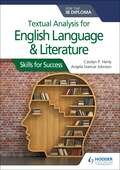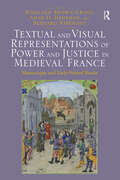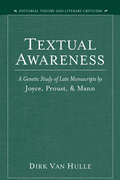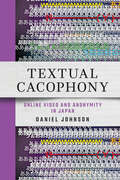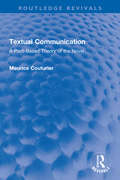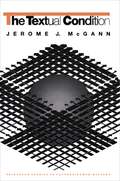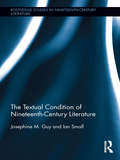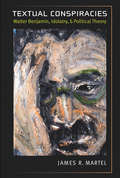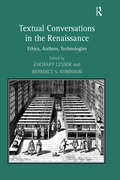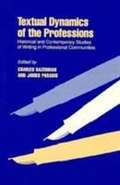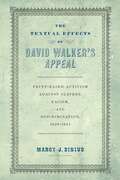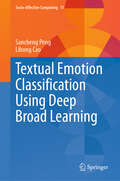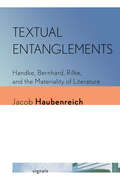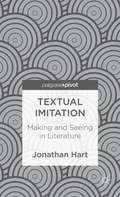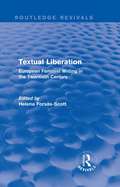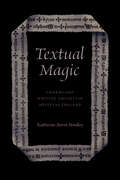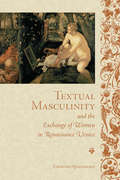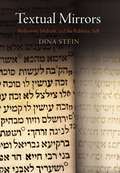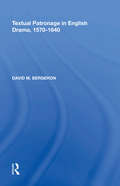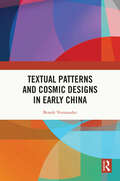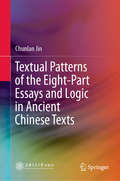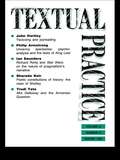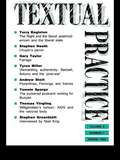- Table View
- List View
Textual analysis for English Language and Literature for the IB Diploma: Skills for Success
by Angela Stancar Johnson Carolyn P. HenlyBuild confidence in a range of key textual analysis techniques and skills with this practical companion, full of advice and guidance from experienced experts.- Build analysis techniques and skills through a range of strategies, serving as a useful companion throughout the course - from critical-thinking, referencing and citation and the development of a line of inquiry to reflecting on the writing process and constructing essays for Paper 1 and Paper 2- Develop skills in how to approach a text using textual analysis strategies and critical theory, for both unseen texts (the basis of Paper 1) and texts studied in class- Concise, clear explanations help students navigate the IB requirements, including advice on assessment objectives and how literary and textual analysis weaves through Paper 1, Paper 2, the HL Essay, Individual Oral and the Learner Profile- Build understanding in how to approach texts so that students can write convincingly and passionately about texts through active reading, note-taking, asking questions, and developing a personal response to texts - Engaging activities are provided to test understanding of each topic and develop skills for the exam - guiding answers are available to check your responses
Textual and Visual Representations of Power and Justice in Medieval France: Manuscripts and Early Printed Books
by Rosalind Brown-Grant Anne D. Hedeman Bernard RibémontThoroughly interdisciplinary in approach, this volume examines how concepts such as the exercising of power, the distribution of justice, and transgression against the law were treated in both textual and pictorial terms in works produced and circulated in medieval French manuscripts and early printed books. Analysing texts ranging from romances, political allegories, chivalric biographies, and catalogues of famous men and women, through saints’ lives, mystery plays and Books of Hours, to works of Roman, canon and customary law, these studies offer new insights into the diverse ways in which the language and imagery of politics and justice permeated French culture, particularly in the later Middle Ages. Organized around three closely related themes - the prince as a just ruler, the figure of the judge, and the role of the queen in relation to matters of justice - the issues addressed in these studies, such as what constitutes a just war, what treatment should be meted out to prisoners, what personal qualities are needed for the role of lawgiver, and what limits are placed on women’s participation in judicial processes, are ones that are still the subject of debate today. What the contributors show above all is the degree of political engagement on the part of writers and artists responsible for cultural production in this period. With their textual strategies of exemplification, allegorization, and satirical deprecation, and their visual strategies of hierarchical ordering, spatial organization and symbolic allusion, these figures aimed to show that the pen and paintbrush could aspire to being as mighty as the sword wielded by Lady Justice herself.
Textual Awareness: A Genetic Study of Late Manuscripts by Joyce, Proust, and Mann
by Dirk Van HulleAware of the act of writing as a temporal process, many modernist authors preserved numerous manuscripts of their works, which themselves thematized time. Textual Awareness analyzes the writing processes in James Joyce's Finnegans Wake, Marcel Proust's À la recherche du temps perdu, and Thomas Mann's Doktor Faustus and relates these to Anglo-American, French, and German theories of text. By relating theory to practice, this comparative study reveals the links between literary and textual criticism. A key issue in both textual criticism and the so-called crisis of the novel is the tension between the finished and the unfinished. After a theoretical examination of the relationship between genetic and textual criticism, Dirk Van Hulle uses the three case studies to show how'at each stage in the writing process'the text still had the potential of becoming something entirely different; how and why these geneses proceeded the way they did; how Joyce, Proust, and Mann allowed contingencies to shape their work; how these authors recycled the words of their critics in order to inoculate their works against them; how they shaped an intertextual dimension through the processing of source texts and reading notes; and how text continually generated more text. Van Hulle's exploration of process sheds new light on the remarkable fact that so many modernist authors protected their manuscripts, implying both the authors' urge to grasp everything and their awareness of the dangers of their encyclopedic projects. Textual Awareness offers new insights into the artificiality of the artifact'the novel'that are relevant to the study of literary modernism in general and the study of James Joyce, Marcel Proust, and Thomas Mann in particular. Dirk Van Hulle is Assistant Professor of English and German Literature, University of Antwerp.
Textual Cacophony: Online Video and Anonymity in Japan
by Daniel JohnsonTextual Cacophony explores the behaviors and routines of communication within anonymous internet culture in Japan. Focusing on the video sharing website Niconico, social media aggregation sites, and the notorious 2channel message board, Daniel Johnson uncovers these sites' complex cultures of writing that obscure meaning through playful and opaque forms of deviant script and overwhelming waves of text. Those practices conflate language with images, meaning with play, and confound individual representation with aggregate forms of social identity. Johnson argues that online media cultures in and around Japan are entwined with a cultural logic and visual syntax of cacophony that expresses ambivalence toward representation, media form, and distinct experiences of time. This aesthetic of cacophony provides an alternative way of expressing social identity and belonging, with an unmarked sense of anonymity providing a counter-form to the dissolving institutions and relationships of neoliberal Japan. Textual Cacophony investigates what it means and feels like to participate in this influential online culture.
Textual Communication: A Print-Based Theory of the Novel (Routledge Revivals)
by Maurice CouturierFirst published in 1991, Textual Communication examines the character and development of the novel from Richardson to Nabokov in relation to the printing and publishing industry. The book blends literary theory with a historical analysis of communication, carrying the debate on the novel beyond the pioneering work of Booth and Genette, while responding to and taking issue with the writings of Foucault, Baudrillard, McLuhan, and Barthes. It analyses the structures of the industry which manufactured and marketed novels to show how novelists solved the communication problems that they faced in the eighteenth, nineteenth, and twentieth centuries. It also pinpoints critical moments in the history of the novel when new narrative strategies appeared, and places them in the context of the communication environment in which the texts were produced. Using Lacan’s theory of the divided subject, the book defines textual communication as a form of interaction in which two divided subjects, the author and the reader, try to communicate with each other under or against the law of the book market, censorship, literary conventions, and language.
The Textual Condition (Princeton Studies in Culture/Power/History #7)
by Jerome J. McGannOver the past decade literary critic and editor Jerome McGann has developed a theory of textuality based in writing and production rather than in reading and interpretation. These new essays extend his investigations of the instability of the physical text. McGann shows how every text enters the world under socio-historical conditions that set the stage for a ceaseless process of textual development and mutation. Arguing that textuality is a matter of inscription and articulation, he explores texts as material and social phenomena, as particular kinds of acts. McGann links his study to contextual and institutional studies of literary works as they are generated over time by authors, editors, typographers, book designers, marketing planners, and other publishing agents. This enables him to examine issues of textual stability and instability in the arenas of textual production and reproduction. Drawing on literary examples from the past two centuries--including works by Byron, Blake, Morris, Yeats, Joyce, and especially Pound--McGann applies his theory to key problems facing anyone who studies texts and textuality.
The Textual Condition of Nineteenth-Century Literature (Routledge Studies in Nineteenth Century Literature)
by Josephine Guy Ian SmallIn this important new book, Guy and Small develop a new account of literary creativity in the late nineteenth century, one that combines concepts generated by text-theorists concerning the embodied nature of textuality with the empirical insights of text-editors and book historians. Through these developments, which the authors term the ‘textual turn,’ this study examines the textual condition of nineteenth-century literature. The authors explore works by Dickens, Wilde, Hardy, Yeats, Swinburne, FitzGerald, Pater, Arnold, Pinero and Shaw, connecting questions about what a work textually ‘is’ with questions about why we read it and how we value it. The study asks whether the textual turn places us in a stronger position to analyze the value of a nineteenth-century text—not for readers of the nineteenth century, but of the twenty-first. The authors argue that this issue of value is central to their discipline.
Textual Conspiracies: Walter Benjamin, Idolatry, and Political Theory
by Martel James R.Engaging political and literary luminaries in an alternative narrative about power
Textual Conversations in the Renaissance: Ethics, Authors, Technologies
by Benedict S. Robinson'Conversation is the beginning and end of knowledge', wrote Stephano Guazzo in his Civil Conversation. Like Guazzo's, this is a book dedicated to the Renaissance concept of conversation, a concept that functioned simultaneously as a privileged literary and rhetorical form (the dialogue), an intellectual and artistic program (the humanists' interactions with ancient texts), and a political possibility (the king's council, or the republican concept of mixed government). In its varieties of knowledge production, the Renaissance was centrally concerned with debate and dialogue, not only among scholars, but also, and perhaps more importantly, among and with texts. Renaissance reading practices were active and engaged: such conversations with texts were meant to prepare the mind for political and civic life, and the political itself was conceived as fundamentally conversational. The humanist idea of conversation thus theorized the relationships among literature, politics, and history; it was one of the first modern attempts to locate cultural production within a specific historical and political context. The essays in this collection investigate the varied ways in which the Renaissance incorporated textual conversation and dialogue into its literary, political, juridical, religious, and social practices. They focus on the importance of conversation to early modern understandings of ethics; on literary history itself as an ongoing authorial conversation; and on the material and textual technologies that enabled early modern conversations.
Textual Dynamics of the Professions: Historical and Contemporary Studies of Writing in Professional Communities
by Charles Bazerman James ParadisTextual Dynamics of the Professions is a collection of fifteen essays examining the real effects of text on professional practices--in academic, scientific, and business settings. Charles Bazerman and James Paradis describe textual dynamics as an interaction in which professional texts and discourses are constructed by, and in turn construct, social practices. In the burgeoning field of discourse theory, this anthology stands apart in its treatment of a wide range of professional texts, including case studies, student papers, medieval letters, and product instructions, and in the inclusion of authors from a variety of disciplines. Invaluable to the new pedagogical field of "writing across the curriculum," Textual Dynamics of the Professions is also a significant intervention into the studies of rhetoric, writing theory, and the sociology of knowledge.
The Textual Effects of David Walker's "Appeal": Print-Based Activism Against Slavery, Racism, and Discrimination, 1829-1851 (Material Texts)
by Marcy J. DiniusHistorians and literary historians alike recognize David Walker's Appeal to the Coloured Citizens of the World (1829-1830) as one of the most politically radical and consequential antislavery texts ever published, yet the pamphlet's significant impact on North American nineteenth-century print-based activism has gone under-examined. In The Textual Effects of David Walker's "Appeal" Marcy J. Dinius offers the first in-depth analysis of Walker's argumentatively and typographically radical pamphlet and its direct influence on five Black and Indigenous activist authors, Maria W. Stewart, William Apess, William Paul Quinn, Henry Highland Garnet, and Paola Brown, and the pamphlets that they wrote and published in the United States and Canada between 1831 and 1851. She also examines how Walker's Appeal exerted a powerful and lasting influence on William Lloyd Garrison's Liberator and other publications by White antislavery activists.Dinius contends that scholars have neglected the positive, transnational, and transformative effects of Walker's Appeal on print-based political activism and literary and book history—that is, its primarily textual effects—due to an enduringly narrow focus on the violence that the pamphlet may have occasioned. She offers as an alternative a broadened view of activism and resistance that centers the works of Walker, Stewart, Apess, Quinn, Garnet, and Brown within an exploration of radical forms of authorship, publication, civic participation, and resistance. In doing so, she has written a major contribution to African American literary studies and the history of the book in antebellum America.
Textual Emotion Classification Using Deep Broad Learning (Socio-Affective Computing #11)
by Sancheng Peng Lihong CaoIn this book, the authors systematically and comprehensively discuss textual emotion classification by using deep broad learning. Since broad learning possesses certain advantages such as simple network structure, short training time and strong generalization ability, it is a new and promising framework for textual emotion classification in artificial intelligence. As a result, how to combine deep and broad learning has become a new trend of textual emotion classification, a booming topic in both academia and industry. For a better understanding, both quantitative and qualitative results are present in figures, tables, or other suitable formats to give the readers the broad picture of this topic along with unique insights of common sense and technical details, and to pave a solid ground for their forthcoming research or industry applications. In a progressive manner, the readers will gain exclusive knowledge in textual emotion classification using deep broad learning and be inspired to further investigate this underexplored domain. With no other similar book existing in the literature, the authors aim to make the book self-contained for newcomers, only a few prerequisites being expected from the readers. The book is meant as a reference for senior undergraduates, postgraduates, scientists and researchers interested to have a quick idea of the foundations and research progress of security and privacy in federated learning, and it can equally well be used as a textbook by lecturers, tutors, and undergraduates.
Textual Entanglements: Handke, Bernhard, Rilke, and the Materiality of Literature (Signale: Modern German Letters, Cultures, and Thought)
by Jacob HaubenreichTextual Entanglements explores how the material processes of writing manifest in the published works of three twentieth-century Austrian authors: Peter Handke, Thomas Bernhard, and Rainer Maria Rilke. These authors left behind material traces of their writing processes, whether in notebooks, piles of disorganized typewritten sheets, or manuscript fragments. The materials do not merely act as containers for their texts: They spill into the semantic content of the writing, becoming entangled in it. The idiosyncratic materials and methods of the writing process do not disappear when the work enters print. Examining these material traces, Textual Entanglements contends that we cannot fully understand these texts' semantic dynamics without considering the material circumstances of their production. Jacob Haubenreich reads Handke, Bernhard, and Rilke to argue that the materiality of textual production opens up a broader semiotic field in which meaning can be created. Haubenreich's book offers a theoretical framework and methodological models for integrating analysis of textual materiality into literary analysis in ways that expand the boundaries of literary interpretation.
Textual Imitation
by Jonathan HartTextual Imitation offers a new critique of the space between fiction and truth, poetry and philosophy. In a nimble, yet startlingly wide-ranging argument, esteemed scholar Jonathan Hart argues that recognition and misrecognition are the keys to understanding texts and contexts from the Old World to the New World.
Textual Liberation: European Feminist Writing in the Twentieth Century (Routledge Revivals)
by Helena Forsas-ScottFeminist writing has emerged in recent years as a major influence of twentieth-century European literature. Textual Liberation, first published in 1991, provides a timely and wide-ranging survey of twentieth-century feminist writing in Europe, presenting texts from a number of countries and highlighting some of the transnational parallels and contrasts. The contributors emphasize the wider contexts- political, social, economic- in which the texts were produced. They cover feminist literature in Britain, Scandinavia, Germany, Eastern Europe, Russia, France, Spain, Italy, and Turkey, and consider a range of genres, including the novel, poetry, drama, essays, and journalism. Each chapter contains an extensive bibliography with special emphasis on material available in English. A stimulating introduction to the development of European feminist writing, Textual Liberation will be an invaluable resource for students of women’s literature, women’s studies, and feminism.
Textual Magic: Charms and Written Amulets in Medieval England
by Katherine Storm HindleyAn expansive consideration of charms as a deeply integrated aspect of the English Middle Ages. Katherine Storm Hindley explores words at their most powerful: words that people expected would physically change the world. Medieval Europeans often resorted to the use of spoken or written charms to ensure health or fend off danger. Hindley draws on an unprecedented archive of more than a thousand such charms from medieval England—more than twice the number gathered, transcribed, and edited in previous studies and including many texts still unknown to specialists on this topic. Focusing on charms from 1100 to 1350 CE as well as previously unstudied texts in Latin, French, and English, Hindley addresses important questions of how people thought about language, belief, and power. She describes seven hundred years of dynamic, shifting cultural landscapes, where multiple languages, alphabets, and modes of transmission gained and lost their protective and healing power. Where previous scholarship has bemoaned a lack of continuity in the English charms, Hindley finds surprising links between languages and eras, all without losing sight of the extraordinary variety of the medieval charm tradition: a continuous, deeply rooted part of the English Middle Ages.
Textual Magic: Charms and Written Amulets in Medieval England
by Katherine Storm HindleyAn expansive consideration of charms as a deeply integrated aspect of the English Middle Ages. Katherine Storm Hindley explores words at their most powerful: words that people expected would physically change the world. Medieval Europeans often resorted to the use of spoken or written charms to ensure health or fend off danger. Hindley draws on an unprecedented archive of more than a thousand such charms from medieval England—more than twice the number gathered, transcribed, and edited in previous studies and including many texts still unknown to specialists on this topic. Focusing on charms from 1100 to 1350 CE as well as previously unstudied texts in Latin, French, and English, Hindley addresses important questions of how people thought about language, belief, and power. She describes seven hundred years of dynamic, shifting cultural landscapes, where multiple languages, alphabets, and modes of transmission gained and lost their protective and healing power. Where previous scholarship has bemoaned a lack of continuity in the English charms, Hindley finds surprising links between languages and eras, all without losing sight of the extraordinary variety of the medieval charm tradition: a continuous, deeply rooted part of the English Middle Ages.
Textual Masculinity and the Exchange of Women in Renaissance Venice
by Courtney QuaintanceTextual Masculinity and the Exchange of Women in Renaissance Venice is a provocative analysis of the pornographic poetry written in patrician poet Domenico Venier's social circle. While Venier and his salon were renowned for elegant love sonnets featuring unattainable female beloveds, among themselves they wrote and circulated poems in Venetian dialect in which women were prostitutes whose defiled bodies were available to all.Courtney Quaintance analyses poetry, letters, plays, and verse dialogues to show how male writers established, sustained, and publicized their relationships to one another through the exchange of fictional women. She also shows how Gaspara Stampa and Veronica Franco, two women writers with ties to the salon, appropriated and transformed tropes of female sexuality and male literary collaboration to position themselves within this homosocial literary economy. Based on archival work and Quaintance's exceptional knowledge of Venetian dialect poetry, Textual Masculinity and the Exchange of Women in Renaissance Venice is an unprecedented window into the understudied world of Venetian literature.
Textual Mirrors: Reflexivity, Midrash, and the Rabbinic Self (Divinations: Rereading Late Ancient Religion)
by Dina SteinAs they were entering Egypt, Abram glimpsed Sarai's reflection in the Nile River. Though he had been married to her for years, this moment is positioned in a rabbinic narrative as a revelation. "Now I know you are a beautiful woman," he says; at that moment he also knows himself as a desiring subject, and knows too to become afraid for his own life due to the desiring gazes of others.There are few scenes in rabbinic literature that so explicitly stage a character's apprehension of his or her own or another's literal reflection. Still, Dina Stein argues, the association of knowledge and reflection operates as a central element in rabbinic texts. Midrash explicitly refers to other texts; biblical texts are both reconstructed and taken apart in exegesis, and midrashic narrators are situated liminally with respect to the tales they tell. This inherent structural quality underlies the propensity of rabbinic literature to reflect or refer to itself, and the "self" that is the object of reflection is not just the narrator of a tale but a larger rabbinic identity, a coherent if polyphonous entity that emerges from this body of texts.Textual Mirrors draws on literary theory, folklore studies, and semiotics to examine stories in which self-reflexivity operates particularly strongly to constitute rabbinic identity through the voices of Simon the Just and a handsome shepherd, the daughter of Asher, the Queen of Sheba, and an unnamed maidservant. In Stein's readings, these self-reflexive stories allow us to go through the looking glass: where the text comments upon itself, it both compromises the unity of its underlying principles—textual, religious, and ideological—and confirms it.
Textual Patronage in English Drama, 1570-1640
by David M. BergeronThrough an investigation of the dedications and addresses from various printed plays of the English Renaissance, the author recuperates the richness of these prefaces and connects them to the practice of patronage. The prefatory matter discussed ranges from the printer John Day's address to readers (the first of its kind) in the 1570 edition of Gorboduc to Richard Brome's dedication to William Seymour and address to readers in his 1640 play, Antipodes. The study includes discussion of prefaces in plays by Shakespeare's contemporaries as well as Shakespeare himself, among them Marston, Jonson, and Heywood. The author uses these prefaces to show that English playwrights, printers and publishers looked in two directions, toward aristocrats and toward a reading public, in order to secure status for and dissemination of dramatic texts. The author points out that dedications and addresses to readers constitute obvious signs that printers, publishers and playwrights in the period increasingly saw these dramatic texts as occupying a rightful place in the humanistic and commercial endeavor of book production.
Textual Patterns and Cosmic Designs in Early China
by Benoît VermanderVia a hermeneutics focused on Chinese numerology and concentric arrangements, this book offers a novel construal of the textual universe proper to early China writings.The author lays bare distinguishable patterns of textual composition while relating them to corresponding patterns of thinking. He differentiates rhetorical variants through detailed studies of the Zhuangzi’s Inner chapters, the Laozi, the Analects, and the Huainanzi. The philosophical depth and relevance of the Chinese ancient worldview appear in a fresh light when one unearths the patterns into which its content is embedded. The focus on textual patterns and rhetorical arrangements also facilitates the reading of Chinese classics alongside other traditions.The book will be a valuable reference for scholars and graduate students studying Chinese literary criticism, Chinese philosophy, and comparative philosophy.
Textual Patterns of the Eight-Part Essays and Logic in Ancient Chinese Texts
by Chunlan JinThis book systematically depicts the theory of textual patterns (chengshi) of the eight-part essays and logic in ancient Chinese texts. With the rare materials, it covers all the basic and important aspects of the whole process and values of chengshi, such as the transformation of different parts and the coherent expression of the doctrines, the planning of writing, and the application to the aesthetic and pedagogic fields. It also explores the similarities and disparities of logical patterns between ancient Chinese and Western texts. Though entirely fresh and tentative, the contrastive studies get new insights into the logic and philosophical concepts hidden in the writings for better understanding of the uniqueness and richness implied in Chinese culture.
Textual Practice: Volume 9 Issue 2
by Daphna Erdinast-Vulcan J. Hillis Miller Peter Nicholls Jo-Ann Wallace Harriet Guest Laurie E. OsborneFirst published in 1995. Routledge is an imprint of Taylor & Francis, an informa company.
Textual Practice: Volume 8, Issue 3
by Terence HawkesFirst published in 1994. Routledge is an imprint of Taylor & Francis, an informa company.
Textual Practice: Volume 8, Issue 1
by Terence HawkesFirst published in 1994. Routledge is an imprint of Taylor & Francis, an informa company.
